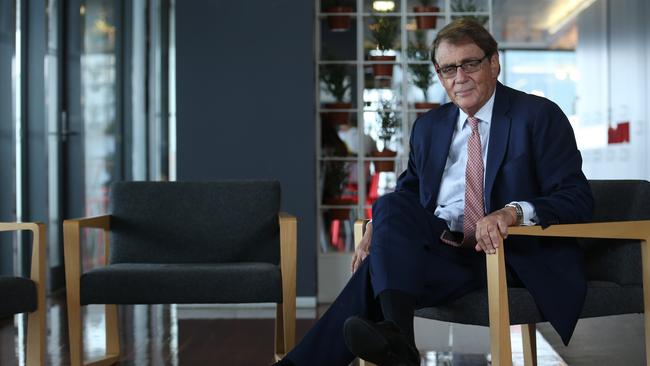
Not only is the RBA likely to extend its quantitative easing again this year, but an extension of its yield curve control policy is also likely as the central bank will want to show that it doesn’t expect to lift the cash rate before the end of 2024, according to a leading economist.
Despite recent sharemarket jitters as bond yields soared last month as COVID-19 vaccinations and US fiscal stimulus plans improved economic growth prospects, the “fear of being behind the curve” no longer dominates central bank thinking and it will no longer be held to account by bond markets.
“The need to be pre-emptive for fear of inflation overshooting and economies ‘overheating’ has been rejected,” Westpac chief economist Bill Evans said.
Australia’s S&P/ASX 200 share index jumped 0.8 per cent to a three-week high of 6827 points on Tuesday, with growth stocks in the technology and healthcare sectors as well as “bond proxies” in real estate and utilities leading gains as the 10-year bond yield fell 10 basis points to 1.69 per cent.
But while the 10-year bond yield will hit 3 per cent by 2024, central banks are prepared to “risk the wrath of the markets” after years of undershooting their inflation and wages objectives”, according to Mr Evans.
Markets in turn were “well advised not to overlook the rule ‘don’t fight the Fed’,” he said.
“Central banks have adequate fire power to stare down markets if they desire.”
In his view, rising bond rates and some uncertainty in the short end of the bond market should not deter the RBA from the objective of reaching its objectives for inflation, wages and employment, thereby “restoring policy credibility after years of consistently missing their targets”.
In the minutes of its March board meeting on Tuesday, the RBA reiterated that it would not lift interest rates until “actual inflation is sustainably within the 2-3 per cent target range”.
“For this to occur, wages growth would need to be materially higher than it is currently,” the minutes said. “This would require significant gains in employment and a return to a tight labour market. The board does not expect these conditions to be met until 2024 at the earliest.”
While a period of very low official rates will always risk financial instability in the housing market, the RBA has “good reason to sound relaxed”, since investor and business credit growth remain weak.
The minutes revealed that after discussing the effect of low interest rates on financial and macroeconomic stability, RBA board members “acknowledged the risks inherent in investors searching for yield in a low interest rate environment, including risks linked to higher leverage and asset prices, particularly in the housing market”.
“Members noted that lending standards remained sound and that it was important that they remain so in an environment of rising housing prices and low interest rates,” the minutes said.
“The board concluded that there were greater benefits for financial stability from a stronger economy, while acknowledging the importance of closely monitoring risks in asset markets.”
But while noting that the RBA has successfully slowed housing markets in both 2015 and 2017 via so-called macroprudential tools and that another round of such policies could be expected sometime next year, Westpac’s Mr Evans said the “authorities will need to be careful not to be too heavy-handed”.
“A repeat of the experience of 2018–2019 when Sydney and Melbourne dwelling prices deteriorated sharply with the unintended consequence of slowing the economy overall will need to be avoided,” Mr Evans said.
In the meantime, a decision by the central bank to extend its yield curve control to target the November 2024 bond will be based on the bank’s forecast timing of when it expects to attain its inflation, wages and full employment targets.
Mr Evans noted that limiting yield curve control to the April bond would imply that the bank gave a reasonable chance to achieving its conditions for the first rate increase by the first half of 2024. But its latest forecasts to mid-2023 have wages growth reaching just 2 per cent, underlying inflation hitting 1.75 per cent and the unemployment rate 5.25 per cent.
RBA governor Philip Lowe said last week that “wages growth will need to be sustainably above 3 per cent” for inflation to be “sustainably within the 2-3 per cent range” and “it is certainly possible that Australia can achieve and sustain an unemployment rate in the low 4’s”.
But despite the prospect of some “noise” in the data from “base effects” on the CPI and the impact on wages and jobs from the unwind of JobKeeper in March, the RBA is unlikely to find reasons to substantially improve its economic forecasts to levels that would be consistent with the expectation that the conditions for the first rate increase will be reached by the first half of 2024.
“Accordingly, our current assessment remains that the bank’s forecasts in the August SOMP will be consistent with an extension of yield curve control to the November 2024 bond,” Mr Evans said.
He expects the RBA to make its decision known by the time of its August Statement on Monetary Policy, since it already owns 60 per cent of the April 2024 bond and “markets remain restive”.
While noting that markets are convinced that the RBA will not extend YCC beyond the April 2024 bond, his analysis of the bank’s current forecasts and prospects for any revisions before the August SOMP indicate that “to maintain credibility, and consistent with its forecasts, the bank will decide to extend the YCC policy to the November 2024 bond.”




Rising bond yields and surging house prices won’t sway the Reserve Bank from providing significant monetary policy support conditions for as long as needed to achieve its objectives.